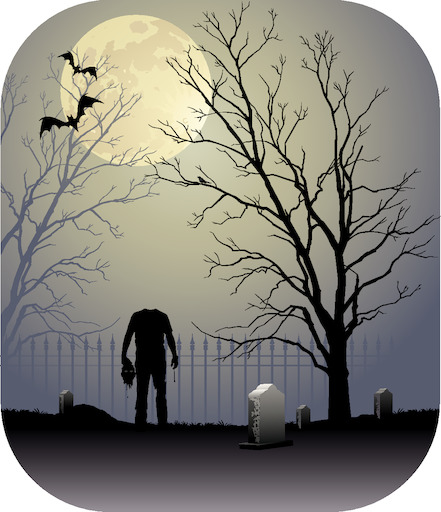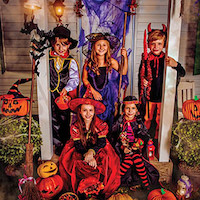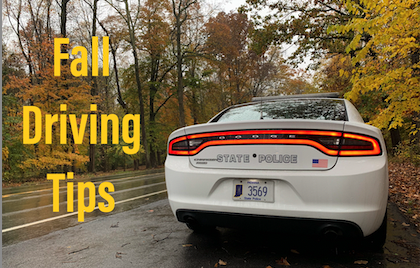
Jeremy Elliott, executive director of the John Hay Center in Salem, wrote this story about an enduring local legend, based on historical facts, that some county residents are only now learning about. Thank you to Elliott and the John Hay Center for sharing the perfect scary story to set the tone during Halloween festivities.
"The Legend of Dead Man’s Holler"
There’s a hollow out along Cox Ferry Road that many generations of county residents say will inspire eerie and foreboding feelings, even if you visit during daylight hours. Something about the location is just a little off or creepy. Some claim it is haunted by a horrible, unspeakable spirit of a bygone era, while others will tell you that its all nonsense, no more than a tale of urban legend. But this Washington County legend is steeped in historical fact.
In the early part of November, 1840, the Johnson County Sheriff and two deputies rode into Salem around breakfast time, after delivering a prisoner to the state penitentiary in Jeffersonville. They stopped at a popular tavern/inn on Main Street to get some breakfast. Also in the tavern at the time, were three Kentuckians, by the name of Hargrave, who had come to town to sell some cattle.
After eating and exchanging pleasantries, the six men got into a political discussion over the impending presidential election, between Martin Van Buren and war hero, William Henry Harrison. Soon enough the men had ordered up a liberal supply of whiskey and they all began taking shots. Both groups of men were strongly committed to their candidates and it didn’t take long for the conversation to turn argumentative. As the whiskey continued to flow, the quarrelling became heated and turned intense, when six-foot, 200-pound, Deputy Sheriff Elias Voorhees stood up and proclaimed that he could personally whip any of his Kentucky opponents.
The eldest of the Hargrave men rose to engage Deputy Voorhees, and quickly all six men were engaged in a full bar-brawl battle. The fight raged on for some time and the men from Kentucky seemed to have got the worst of it. After collecting their bloodied selves from the tavern floor, the three Kentuckians fled the tavern and immediately ran to the Justice of the Peace, Alexander Crooke, to file charges of assault against the Johnson County lawmen. Crooke, true to his position, issued affidavits and had the three Hoosiers arrested and detained for a trial at sundown. Somehow, just before dark, Deputy Voorhees managed to escape and get back to his horse. He galloped away from town, in a flurry, before the hearing could commence.
When there was not an immediate pursuit of the fleeing man by local law enforcement, the Hargreaves felt they weren’t getting a fair deal. So they offered up a cash bounty to anyone who would hunt down, re-arrest and return Voorhees to town for the trial.
Four young local men eagerly volunteered, armed themselves and set off in pursuit of the fugitive. The four amateur bounty hunters, Jeremiah Dennis, Isaac Gordon, Mike Atkinson and John Goodwin, were gone the rest of that night and did not return until the following evening. They reported to everyone that they were unable to find even a trace of Voorhees and had heard no word or gossip on his whereabouts.
In the gauzy light of the predawn hours of November 6th, two young Washington County boys, Phineas Little and John Williams, were out hunting cattle along Cox Ferry Road, when they made a horrendous discovery. Out in the field, a few rods from the road, was the ghastly, decapitated head of a man, stuck atop a wooden stick in the ground and his headless body was lying nearby, under a tree. The two boys took off down the road, screaming “bloody murder”!
People for miles around came running to the sight to learn the identity of the individual, scrutinize the murder scene, or simply to observe the macabre. It was quickly discovered that the corpse was that of Johnson County Deputy Sheriff Elias Voorhees. He had been shot through the heart and killed instantly. The assassins then used a large hunting knife to cut off his head and placed it on the pike. Suspicions immediately turned to the four local men, who had attempted to collect the Hargrave’s bounty. They were accordingly arrested and charged with first degree murder. A tense environment erupted in Salem, as the county residents were certain of the local men’s guilt, and rumors began to circulate that there would be a lynch-mob formed to exact justice for the grisly murder.
Due to the anxious circumstances, the defense attorney requested and received a change of venue, and the case was transferred to Harrison County. When the proceedings took place in Corydon, the case was hotly contested and there were a number of incriminating facts that made it look bad for the prisoners.
However, the change of venue caused complications for the prosecution, as they were unable to produce some of the evidence and several of their witnesses failed to make the journey to the Harrison County seat. After deliberations, the jury voted to acquit the Washington County men, and they were set free. But the testimony delivered in the court room left little doubt in the minds of the public that Goodwin and Dennis had perpetrated the crime, while Atkinson and Gordon were accessories to the fact and cognizant of the truth in the matter.
Prior to his beheading, Deputy Elias Voorhees had been born in 1814, in Mercer County, Kentucky, and had migrated across the Ohio River as a child with his parents, settling around Franklin, Indiana. Elias was only 26 years old at the time of his murder and left behind, a widow, Eleanor Davis, a three year old son, Andrew, and an infant daughter, Martha.
The hollow, a few miles northwest of Salem’s city limits on Cox Ferry Road, has been said to be haunted by this man’s spirit, since the incident occurred and over the years garnered the nickname of “Dead Man’s Holler”.
Through the many years since, numerous people have claimed, in the wee hours of night, to have seen a headless apparition, dressed in clothes from another time era, roaming along in the fields beside the road. Some say the spirit they saw had no head at all, while other witnesses claim the Voorhees doppelganger was carrying his head in his hand, held outright, like you would with a lantern trying to find your way through the darkness.
Despite the similarities, there have not been any reports of this spirit riding a horse and smashing pumpkins, but it is certainly easy to imagine the unrest of Voorhees’ spirit and his fruitless pursuit of justice for his gruesome, wrongful and untimely death.
It has been some years since anyone has claimed to have seen the ghost of Elias Voorhees, but remember the veil between the world of the living and the world of the dead is said to be the thinnest around the time of Halloween. So the members of the county historical society wouldn’t be as shocked as the observer if Deputy Voorhees were to make another appearance, still aimlessly wandering between two realms, 175 years after his brutal murder.
These are the known facts, of the 1840 case, of Elias Voorhees and the Legend of Dead Man’s Holler, in the historically rich and fascinating lands of Washington County, Indiana.

Many parents find that anywhere between ages 11 and 13 are good times to let their children go trick-or-treating with friends. However, this decision may be based on several factors.
Kids go through many rites of passage throughout childhood. There is the first time they go to school and leave parents behind for several hours per day. Another rite is sleeping over at a friend or family member's house or even summer camp. Still another may be being allowed to attend a movie alone with a friend. Small rites of passage signify a child is getting older and is ready for more responsibility and trust. Such may be the case when parents conclude that their children are ready to engage in Halloween fun without an adult chaperone.
There is no set age when a child can walk around the neighborhood trick-or-treating unattended. Just as with other tests of responsibility, such as staying home alone or being able to ride bikes with friends, it is up to parents to gauge their youngsters' readiness. Halloween for older children often is less about candy and more about hanging out with friends. Therefore, parents probably needn't worry that their kids will be traveling solo since a large group of children will likely be visiting homes together. Many parents find that anywhere between ages 11 and 13 are good times to let their children go trick-or-treating with friends. However, this decision may be based on several factors.
· Time of day: It's best to limit a first time trick-or-treating without parents to daylight hours. What looks familiar during the day may be less familiar after sunset. It's generally safer for kids to be out and about before night falls.
· Other participants: Parents should weigh the personalities of their kids' friends as well. For those who are assured that others in the group are mature and responsible, there's no need to continue to clip the proverbial wings of trick-or-treaters. But if parents are leery of any shenanigans that may take place, it may be better to wait things out a little longer.
· The neighborhood: Is the area relatively safe with limited vehicle traffic? If so, then parents may feel more comfortable letting kids on the younger range of that age spectrum trick-or-treat without them. Urban neighborhoods or ones where houses are separated by a lot of land may warrant some adult supervision.
· Constant contact: Parents who utilize GPS apps to keep tabs on their children's whereabouts may feel more comfortable letting them trick-or treat with friends. These apps will show exactly where the child is at the time and can trace the route kids take. Many children get smartphones while young, which can alleviate concerns about getting in touch or keeping track of kids left to their own devices.
When to let kids go out trick-or-treating without adults is a decision each family needs to make based on their unique circumstances and preferences.

|
|
|
|
Indiana Capitol Tour Office |

By Sgt. Carey Huls, Public Information Officer, Indiana State Police Sellersburg District
Halloween, pumpkin spice, football...Fall is upon us. But costume parties and football rivalries are not the only things for which we need to prepare. Falling leaves and colder temperatures are making their appearance as well. With these changes come driving hazards more unique to autumn than other times of the year.
According to the Institute of Highway Safety, autumn typically brings a sharp increase in the amount of car versus animal insurance claims, most of those being deer. These claims usually peak in the month of November and decrease through December and January. Wet leaves, colder temperatures, and an increase in rainfall also add to the mix.
Your friends at the Indiana State Police Post in Sellersburg would like to remind you of these tips as you navigate our changing roadways:
- WET LEAVES: Wet leaves can be as slippery as an ice-covered roadway. Drive slowly on leaf-covered roads and avoid hard braking. Also, don't forget that leaves can obscure lane and roadway markings, so make sure to pay attention to the edge of the roadway and stay in your lane.
- RAIN AND FOG: Wet roads are slippery and may lead to hydroplaning. Increase your following distance, and don't use cruise control. If it's foggy, use your low beams or fog lights and avoid using high beams.
- BRIDGES AND OVERPASSES: Any roadway not in direct contact with the ground can freeze quickly. Morning frost can leave icy patches, and shaded areas may remain icy after other parts of the roadway are dry.
According to the National Highway Traffic Safety Administration, there are approximately 1.5 million deer-vehicle collisions each year. According to insurance industry statistics, Indiana usually ranks in the middle of all 50 states and was 24th in 2021 in car versus animal crashes. In 2021, the odds for a car/animal crash were 1 in 100. West Virginia typically tops the charts with the odds at 1 in 37.
When it comes to our four-legged friends:
- BUCKLE UP! Sudden stops from a collision or even hard braking are common causes of injury. Your seatbelt is the best protection to help prevent you or your passengers from being harmed.
- WATCH FOR SIGNS. Deer crossing signs are there for a reason. Use caution when you see these signs and remember that deer often travel in groups. If you see one, assume more are nearby. Don't forget to recruit your passengers to assist in looking for deer.
- WHAT TIME IS IT? Deer are active at dawn and dusk as they look for food. This time of year is also their migration and mating season, which is another reason they are more active.
- DON'T SWERVE. If a crash is unavoidable, don't swerve to avoid hitting the deer. Not only could you swerve into the path of another car, but you could also lose control of your vehicle and possibly roll over. Brake firmly and stay in your lane. Studies show more serious crashes happen when we swerve to avoid an animal.
- I STRUCK A DEER, NOW WHAT? Unfortunately, even if you take all the above precautions, sometimes car/deer crashes are unavoidable. If you do have a collision, remember to move your car off the roadway and call 911 or your nearest police agency. Typically, comprehensive insurance coverage will cover these crashes, so make sure you contact your insurance agent and, if possible, take photographs of your car and the animal.

It is essential to prioritize safety on Halloween, and following these guidelines can help.
Halloween is enjoyed by people of all ages, but few get a bigger kick out of the holiday than children. There are costumes to be worn, time spent with friends and the opportunity to collect free candy and other treats.
Although Halloween can be a fun time, the Children's Safety Network warns that it's also a time when accidents can happen. According to the CSN, the most dangerous day for child pedestrians is Halloween, with two times as many child pedestrians dying on Halloween compared to other days. It is essential to prioritize safety on Halloween, and following these guidelines can help.
· Make sure costumes are short. Costumes that drag on the floor are tripping hazards, which can lead to injury. Be sure that costumes do not cover the feet or drag on the ground.
· Trick-or-treat in groups. Children are safer in numbers due to the increased visibility of a crowd and because, if something happens, others can call for help. Parents can use their discretion on what age they feel is mature enough to let children go out alone. Until then, children should be accompanied by adults.
· Improve visibility. It's important to be seen while trick-or-treating, and that can be achieved by making sure costumes and trick-or-treat bags feature reflective tape. Trick-or-treaters also can carry flashlights or glow sticks to improve visibility, and stick to areas with streetlights if going out after dark.
· Stay on sidewalks. Whenever possible, trick-or-treaters should stick to the sidewalks and avoid walking on the roads. This may not always be possible in neighborhoods without sidewalks, where parents and youngsters must be especially careful.
· Eat before trick-or-treating. A meal or snack before trick-or-treating can reduce the tendency to fill up on candy while out and about. All candy and other treats should be inspected by an adult before it is eaten.
· Keep pets locked away. Animals can become skittish when there are many people loitering outside of homes or ringing doorbells. Keep pets in a quiet room away from the action to prevent them from getting loose, injured or scared enough to bite or scratch someone.
· Avoid masks that obstruct vision. It can be hard to see peripherally with a mask on, so avoid costumes with masks that compromise vision.
· Test out makeup beforehand. All makeup used for costumes should be tested for allergic reactions prior to use. Heed the warnings on packaging and avoid putting makeup too close to the eyes or lips.
These are some safety strategies designed to keep Halloween fun and incident-free this year.
SalemLeader.com
Leader Publishing Company of Salem, Inc.
P.O. Box 506
117-119 East Walnut Street
Salem, Indiana. 47167
Phone: 812-883-3281 | Fax: 812-883-4446
Business Hours:
Mondays through Fridays, 9:00am - 5:00pm
News:
news@salemleader.com
Office:
office@salemleader.com
Publisher:
publisher@salemleader.com
Business
- More Business News
- Go To Guide
- Business Directory
- Auctions
Education
- More Education News
Opinion
- Editorials
- Letters to the Editor
- Columns
- Unsung Heroes
- Days Gone By
- In the Garden
- Guest Columns
- Reader's Poll
- Salem Leader Forum
- Questions and Answers
Church
- Bible Aerobics
- Church News
- Church Directory










